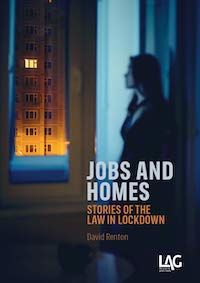The 2016 Ken Loach film I, Daniel Blake features a single mother forced by the housing system to move from London to Newcastle. Despite winning the Cannes film festival’s Palme d’Or, it was dismissed as “a work of fiction” by government minister Greg Clark.
Technically, of course, that was true. But the scenario the film described is very real for many people. Researching my 2017 book on the housing crisis, Big Capital, I visited a housing law centre in Hackney. In a tiny, cramped office overflowing with case files, a lawyer told me similar stories. Families were being forced to move out of London to Slough, Maidenhead, Leicester, Luton and Coventry, to homes they had to accept or risk being labelled “intentionally homeless,” and therefore beyond the reach of the duty on councils to house their citizens. Those who tried to fight the move, which would rip them away from their schools, families and support networks, went to court, where sometimes they won and sometimes they lost.
David Renton, the author of Jobs and Homes, is a housing and employment barrister who takes cases like this in court. In a book that could so easily have been mired in obscure jargon and dry statistics, Renton highlights the human stories he encounters on a daily basis. Housing is a complex area, especially when it interacts with the benefits system, and there is a woeful lack of scrutiny. As a result of Margaret Thatcher’s Right to Buy policy, which saw the sale of more than two million council homes, today more than 40 per cent of former council homes are owned by private landlords who rent them out at three or four times the cost of social housing rents.
Alongside Right to Buy, councils were banned by law from using the revenue raised from the sale of council homes to build new ones. Successive governments subsidised poor people to live in private rented housing instead, where rising rents were paid by housing benefit. To curb the soaring housing benefit bill, in 2011 David Cameron’s coalition government moved to impose cuts to what was by then called local housing allowance. Housing benefit had previously covered typical homes in an area, but it was now capped to cover roughly the cheapest third of local private rents.
The free-market hope here was that tenants, newly exposed to the consequences of paying high rent, would have more of an incentive to “shop around,” exerting competitive pressure on landlords. But by 2019, it was clear that this was a very expensive policy failure. In many areas, rents were not significantly lower, and the housing benefit bill ran up to £22bn a year, with around half going to private landlords. Rents continued to rise despite the cap, and as a consequence the benefit no longer meets the cost of the rent: London renters face, on average, a gap of more than £200 a month, leading to penury when the difference is paid out of subsistence safety-net benefits, and frequent evictions when the rent goes unpaid. At the same time, rewards have been engineered for landlords in cheaper parts of the country to work with rich London boroughs such as Westminster, Kensington & Chelsea and Hammersmith & Fulham, to export people out of the city. Even those tenants represented by Renton who are in work (and many of them are) simply cannot pay the rising rents.
“Forty per cent of former council homes are owned by private landlords, for high rents”
Renton’s case studies are ones of high drama, peopled by a Dickensian cast. As names and identities have been changed, his habit of giving aptronyms to his more villainous characters adds flair to the narrative: for example, we meet the icy and incompetent manager Charmaine Baccarat, and the museum director Thornton Edsell, with his diamond-blond hair and chiselled jaw. One of his regular adversaries is Tuck, a barrister who acts for landlords, who always sports polished brogues. After one case, Tuck says to him: “I don’t know how you do it.” “Do what?” Renton replies. To which Tuck says simply, “tenants,” looking at him not with contempt but confusion, unable to understand why a barrister would wish to spend his life defending people whom Tuck regards as distasteful.
Renton himself is very aware of his own status as a highly educated white male with an aristocratic background. He is treated far more kindly by the judges than his clients are. One judge tells him that in 10 years Renton will be sitting where he is and presumably making the same kinds of decisions. This is a fate Renton roundly rejects: he is determined instead to give a voice to the voiceless, both by providing legal representation and by telling their stories in this book.
This highly personal work is structured as a month-by-month account of events during lockdown. Renton interweaves his cases with a personal crisis: his father has a fall and goes into hospital, becomes confused and gets worse. For all the differences in circumstances, in crucial respects his own story here mirrors some of the experiences of his clients.

Many of the cases that he recounts are victories, but when he does lose, the consequences can be fatal. One of his more memorable cases concerned Ronald, a colourful man in his 70s who had once worked with Sid James. Ronald’s son had died in an accident, and he had been an alcoholic ever since, devoting all his love to his dog Guinness. Ronald was not able to walk the dog as much as it needed, and so Guinness barked all through the night. His neighbours demanded his eviction. The judge ordered that Ronald rehouse Guinness, which he would not, or could not, do. At the hearing Ronald’s solicitor took the unprecedented step of taking the dog herself to his friend’s home, where Ronald could visit him.
It looked like Renton had won the case, but months later he was back in court: Guinness had returned to live with Ronald and the landlord demanded eviction. This time Ronald lost his home and the council did not rehouse him. Now homeless, he was admitted to hospital where he died. In complex cases like this, where mental health is the determining factor, the court system lacks the capacity to respond with due care.
In another case, a father and his two children were living in one room in a Premier Inn after the council claimed they had made themselves intentionally homeless as a result of rent arrears. The children’s headteacher provided evidence that the family was suffering: the youngest had become unruly and refused to eat lunch; the older was unable to make friends. Although Renton won, he didn’t feel a sense of victory. If the man fell into rent arrears again, which was highly likely given the substantial gap between benefits and rent, the council could run the same argument again.
Half a million private-sector tenants were paying more than half their income in rent before lockdown. That is compared to the average mortgaged household, which spends less than one-eighth of its income on housing. The average household letting privately spends more than a third of its income on rent; the majority of London’s private renters spend more than half. With that sort of proportion, the moment there is any other pressure on family budgets, the threat of eviction looms—which is no doubt why research suggests that mental health suffers when more than a third of income is eaten up by rent.
In the first six weeks after lockdown, two million people made claims for universal credit (which is steadily replacing earlier benefits, including housing benefit) and the book recounts how confusion surrounded the status of renters. While mortgage holidays were announced, there were no holidays from rent, although after weeks of uncertainty eviction orders were put on hold. With the eviction ban lifted this June, the Joseph Rowntree Foundation warned that 400,000 households could be forced out of their homes, with another 450,000 behind on rent across the country.
During lockdown, those hearings that did take place moved online. Over the last decade, there has been rising pressure for online hearings, owing to the closure of courts: between 2010-2019, 162 of 323 magistrates’ courts closed and 90 of 240 county courts, amounting to well over a third of the court system. The acceleration of online hearings disturbs Renton. As courts shut, he describes “advice deserts,” where the entire infrastructure of public legal advice is displaced, threatening high-quality representation. Renton points to the importance of face-to-face contact, highlighting that it is easy to marginalise participants in a virtual hearing.
“For the time being a catastrophe has been deferred, but not averted”
The question that looms over the book is, has Covid made the precarity of life for private renters more or less extreme? Debt spiralled, but evictions were halted for a time and the sheer volume of cases and backlog in the system means that the crisis is not likely to be felt until later in the year. For the time being a catastrophe has been deferred, but not averted.
In one notable case regarding the care of a vulnerable adult male, the hearing proceeded quickly, but the man’s daughter became invisible to the court after her evidence was heard, when the other users turned off her video. She felt that “Skype took away from me the ability to look these people in the eyes.” With perennial budget pressures and legal aid an unpopular cause, there is a danger that due procedures could be withdrawn from housing. The dystopic vision would be a world without lawyers, with online housing courts where the human voice is not fully heard, and where judgments are determined by algorithms. Renton implies we may already be closer to this nightmare than we might think.

Jobs and Homes: Stories of the Law in Lockdown by David Renton (Legal Action Group, £20)












